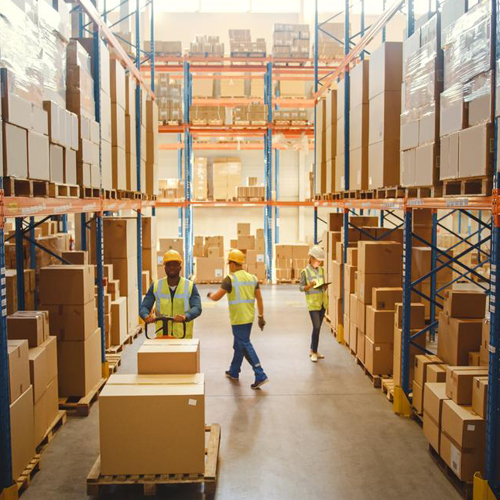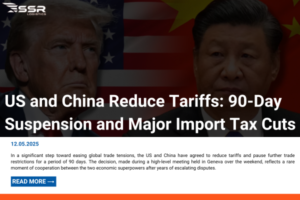The garment industry is relatively developed in Vietnam. Therefore, the demand for importing garment fabrics is also extremely high. However, not everyone knows what steps are involved in importing garment fabrics and what legal documents are required. The following article will provide complete information on the process and procedures for importing garment fabrics so readers can better understand!
Assessment of the current demand for the garment market in Vietnam
The garment market in Vietnam is currently growing strongly, as shown by many specific figures:
- Industry growth: In 2023, the Vietnamese textile and garment industry will achieve export revenue of about 39 billion USD, an increase of 10% compared to 2022.
- Domestic demand: Domestic garment consumption will reach about 4 billion USD in 2023.
- Global market share: Vietnam is the third largest garment exporter in the world, after China and Bangladesh.
- Fabric imports: In 2023, Vietnam will import about 13 billion USD of fabric and textile materials, an increase of 7% compared to 2022.
- Increase in international brands: Major brands such as Zara, H&M, and Uniqlo have expanded their operations in Vietnam, boosting demand for high-end and fast fashion garments.
- Foreign investment: FDI in the textile and garment industry is expected to reach about 2 billion USD in 2023, showing the attractiveness of the Vietnamese market to international investors.
- Exports to the US and EU: The US and EU are Vietnam’s two largest export markets, accounting for about 50% of total garment exports.
- Domestic growth: Garment retail sales in the domestic market will increase by 12% in 2023, showing increased consumer spending.
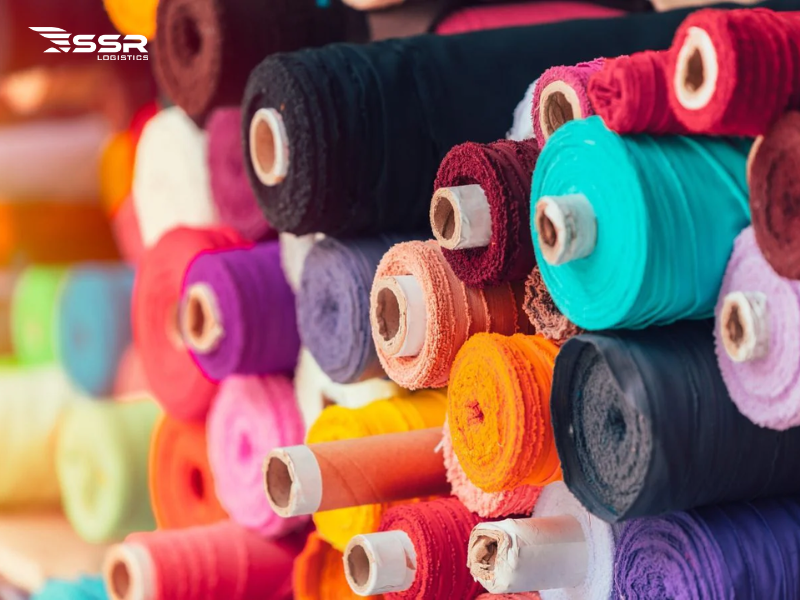 The garment industry in Vietnam is currently developing strongly
The garment industry in Vietnam is currently developing strongly
The above figures show that the Vietnamese garment market is in a period of strong development, with many opportunities and challenges for businesses in the industry.
Legal regulations on procedures for importing garment fabrics
Garment fabrics are not prohibited from import and export in Vietnam; therefore, individuals and businesses are allowed to import this type of goods into the country.
However, when importing garment fabrics, you need to understand the following regulations:
- Circular 21/2017/TT-BCT dated October 23, 2017 of the Ministry of Industry and Trade stipulates the limit of Formaldehyde and Aromatic Amines derived from Azo dyes in textile products.
- Circular 07/2018/TT-BCT dated April 26, 2018 of the Ministry of Industry and Trade amends Circular 21/2017/TT-BCT dated October 23, 2017 on national technical regulations related to Formaldehyde and Aromatic Amines derived from Azo dyes in textile products.
Based on the two documents mentioned above, businesses need to ensure that their products comply with national technical regulations. In case they do not comply with the regulations, they will not be allowed to distribute the products on the market.
HS Code and tariff schedule of garment fabric
HS Code of Garment Fabric
Each type of fabric will have a different HS Code. According to regulations, the HS code of fabric belongs to Part XI – Textile materials and textile products in the tariff schedule. HS code details are as follows:
| MÃ HS | MÔ TẢ HÀNG HÓA |
|
Mã HS vải từ tơ tằm |
|
| 50071020 | Vải dệt thoi từ tơ tằm vụn, chưa hoặc đã tẩy trắng |
| 50071030 | Vải dệt thoi từ tơ tằm vụn, đã được in bằng phương pháp batik truyền thống |
| 50072020 | Các loại vải dệt thoi khác, có chứa 85% tơ tằm trở lên chưa hoặc đã tẩy trắng |
| 50072030 | Các loại vải dệt thoi, có chứa 80% tơ tằm trở lên, đã in bằng phương pháp batik truyền thống |
| 50072090 | Các loại vải dệt thoi khác, có chứa 85% tơ tằm trở lên loại khác |
| 50079020 | Các loại vải tơ tằm khác đã hoặc chưa tẩy trắng |
| 50079030 | Các loại vải tơ tằm được in bằng phương pháp batik truyền thống |
| 50079090 | Vải tơ tằm khác |
| Mã HS vải dệt thoi từ lông động vật | |
| 51111100 | Vải từ lông cừu hoặc lông động vật chải thô, loại hàm lượng 85% trở lên, trọng lượng không quá 300 g/m2 |
| 51111900 | Vải từ lông cừu hoặc lông động vật chải thô, loại hàm lượng 85% trở lên, loại khác |
| 51112000 | Vải từ lông động vật chải thô, pha với sợi filament nhân tạo |
| 51113000 | Vải từ lông động vật chải thô, pha với xơ staple nhân tạo |
| 51119000 | Vải từ lông động vật chải thô |
| 51121100 | Vải dệt thoi từ sợi len từ lông động vật mịn 80% chải kỹ, trọng lượng không quá 200g/m2 |
| Mã HS vải dệt thoi từ bông | |
| 52081100 | Vải dệt thoi từ bông 85% trở lên, vải vân điểm, trọng lượng không quá 100g/m2, chưa tẩy trắng |
| 52081200 | Vải dệt thoi từ bông 85% trở lên, vải vân điểm, trọng lượng trên quá 100g/m2, chưa tẩy trắng |
| 52081300 | Vải dệt thoi từ bông 85% trở lên, vải vân chéo 3 sợi hoặc vân chéo 4 sợi, kể cả vải vân chéo dấu nhân, chưa tẩy trắng |
| 52081900 | Vải dệt thoi từ bông 85% trở lên, vải dệt khác chưa tẩy trắng |
| 52082100 | Vải dệt thoi từ bông 85% trở lên, vải vân điểm, trọng lượng không quá 100g/m2, đã tẩy trắng |
| 52082200 | Vải dệt thoi từ bông 85% trở lên, vải vân điểm, trọng lượng trên quá 100g/m2, đã tẩy trắng |
| 52082300 | Vải dệt thoi từ bông 85% trở lên, vải vân chéo 3 sợi hoặc vân chéo 4 sợi, kể cả vải vân chéo dấu nhân, đã tẩy trắng |
| 52082900 | Vải dệt thoi từ bông 85% trở lên, vải dệt khác đã tẩy trắng |
Types of taxes when importing garment fabric
Procedures for importing garment fabrics into Vietnam, enterprises need to pay import tax and value-added tax (VAT) based on the HS code of each type, specifically:
- Value-added tax (VAT) for garment fabrics ranges from 5% to 10% (depending on each HS code).
- Preferential import tax for garment fabrics can range from 5% to 20% (depending on each HS code).
+) Importing fabrics from Japan, preferential import tax can range from 0% to 12%.
+) Importing fabrics from Korea, preferential import tax is usually from 0% to 20%.
+) Importing fabrics from Thailand/Indonesia/Malaysia, the preferential import tax is 0%.
+) Importing from countries that have signed Free Trade Agreements with Vietnam and goods that meet the necessary conditions, enterprises can enjoy special preferential import tax.
Garment fabric import dossier
Customs documents for importing garment fabrics
The customs documents for importing garment fabrics that need to be prepared include:
- Commercial Invoice
- Import goods declaration
- Packing List
- Bill of lading
- Certificate of origin (This document will help businesses enjoy special preferential import tax)
- Certificate of conformity
- Other documents (if any)
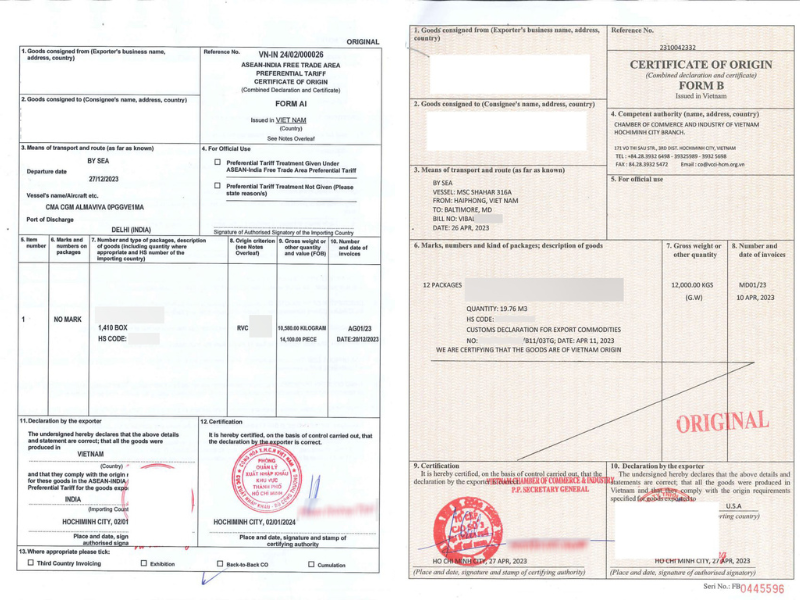 Certificate of origin of goods will help enterprises enjoy special preferential import tax
Certificate of origin of goods will help enterprises enjoy special preferential import tax
Conformity declaration dossier
To declare conformity, organizations, individuals and enterprises need to prepare 2 sets of conformity declaration dossiers as follows:
- The dossier is submitted directly to the Department of Industry and Trade at the central level via post or the one-stop information portal of provinces and cities.
- The individual, organization and enterprise keep the dossier.
The dossier for conformity declaration according to Circular 21/2017/TT-BTC includes:
* In case of declaring conformity based on self-assessment results from an organization or individual (first party), the dossier must include:
– Declaration of conformity (according to Form 01 attached to the Regulation);
– Self-assessment report with the following information:
- Name and contact information of the organization or individual;
- Information about the product or goods;
- Reference number of the technical regulation;
- Conclusion on the conformity of the product or goods with the technical regulation;
- Commitment to the quality of the product or goods according to the technical regulation and take full legal responsibility for the quality and self-assessment results.
– For imported goods, the following information must be added:
- Information about the brand, type, and technical characteristics;
- Origin, manufacturer;
- Volume, quantity;
- Import gate, import time;
- Information on the contract, list of goods, invoice, bill of lading or equivalent transport document if there is no specific bill of lading.
* In case of declaring conformity based on the results of certification or inspection from a competent organization (third party), the dossier must include:
- Conformity declaration (according to Form 01 specified in Appendix V of this Regulation).
- Official copy of the Certificate of conformity with this technical regulation, including the sample of the conformity mark issued by the designated certification or inspection organization to the organization or individual.
Garment Fabric Import Procedures
The garment fabric import procedures are similar to those of other imported goods, specifically:
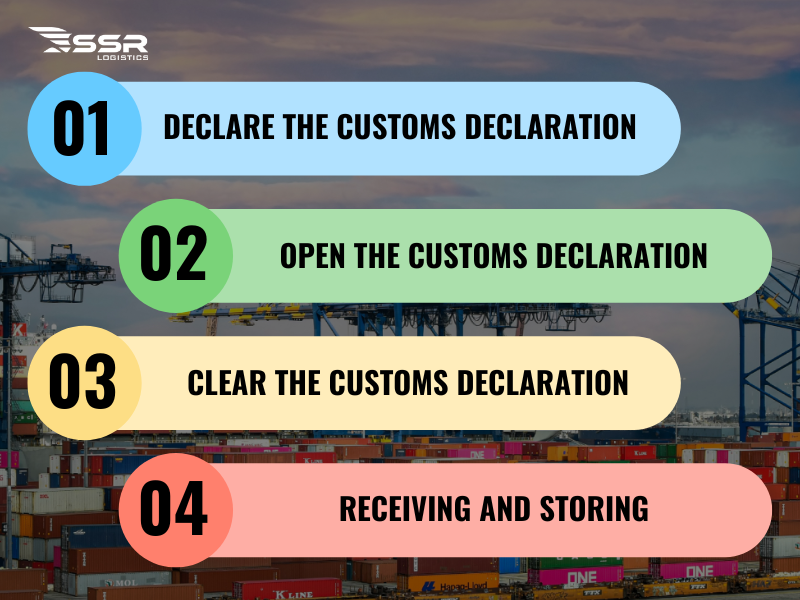 Garment Fabric Import Procedures
Garment Fabric Import Procedures
Step 1: Declare the customs declaration
Collect the necessary documents, then enter the declaration information into the customs system through the software.
To ensure an accurate declaration, you need to understand the steps of the customs declaration. If you do not understand how to use the system, you should avoid doing it yourself because mistakes can cause serious consequences, especially when having to correct incorrect information on the customs declaration.
Step 2: Open the customs declaration
Once the customs declaration is completed, the system will classify the declaration. Based on the type of classified stream, you need to print the declaration and submit the import documents to the customs office to open the declaration. The declaration opening process will be different depending on whether the declaration is in the green, yellow or red stream.
Step 3: Clear the customs declaration
After checking and confirming that there are no problems, the customs officer will accept the declaration for clearance. At this point, you can proceed to pay import tax to complete the customs clearance process.
Step 4: Receiving and storing
After completing customs clearance, you need to carry out the procedures for clearing the declaration and bringing the goods to the warehouse for storage. These are the four basic steps in the customs clearance process for imported goods, especially for textiles.
Notes during the process of importing fabrics
During importing garment fabrics, accurately declaring information about the goods is important to ensure a smooth import process.
Declared information includes:
- Name of goods
- Material composition: percentage of wool, poly, origin of wool, etc.
- Weaving technology: woven, knitted, non-woven
- Uses: garment, curtains, etc.
- Fabric width: length, width, weight
- Fiber density or quantity
In addition, the certificate of origin (C/O) is a very important document. It not only helps businesses easily clear customs but also helps businesses enjoy incentives.
SSR Logistics – A reputable and quality garment fabric import procedure unit
Procedures for importing garment fabric are mandatory procedures, requiring strict compliance with import and export regulations. The process of carrying out this customs procedure is relatively complicated, time-consuming and requires a lot of expertise. Understanding this, SSR Logistics was born with the mission of becoming a reputable partner to support businesses in carrying out fabric import procedures quickly, effectively and cost-effectively.
Why choose SSR Logistics?
- Experienced staff
- Professional process
- 24/7 dedicated support
- Competitive price
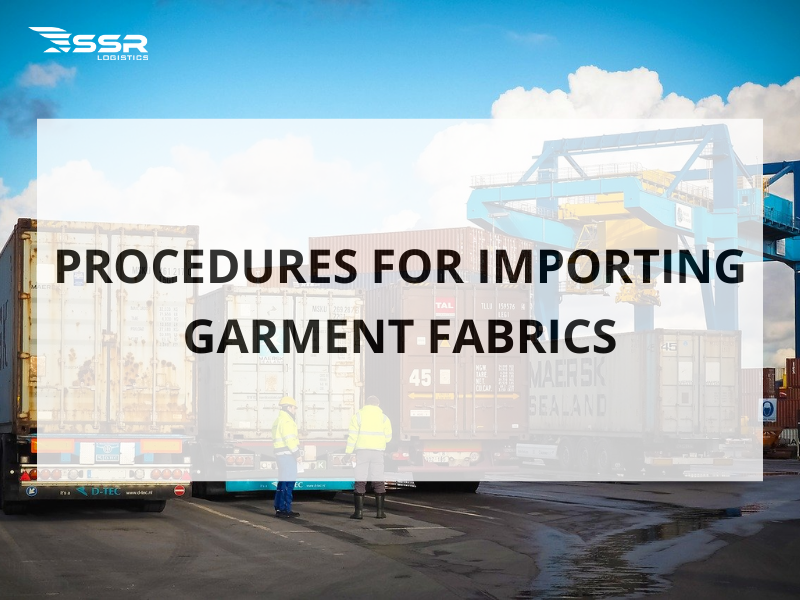 SSR Logistics performs full package of garment fabric import procedures
SSR Logistics performs full package of garment fabric import procedures
SSR Logistics’s Fabric Import Procedures service includes:
- Free consultation on Fabric Import Procedures
- Support in preparing complete and accurate Fabric Import Procedures
- Submit documents and monitor the progress of Fabric Import Procedures
- Consult on solutions in case of problems
- Provide import and export freight services
With SSR Logistics, you can be completely assured of the implementation of Fabric Import Procedures. We are committed to providing you with professional, reputable and effective services, helping you save time and costs.
Through this article, SSR Logistics hopes that customers have an overview of Fabric Import Procedures in import and export. To explore more diverse knowledge in the field of logistics, please visit our Logistics Knowledge section.
SSR looks forward to becoming your reliable logistics partner, providing optimal solutions for your import and export business. If you have questions about our services, please contact us for specific advice.
With our experienced team, extensive network and flexible shipping & customs solutions, SSR Logistics is confident to deliver excellent services to our clients.
Businesses that need customs and import-export, please contact SSR Logistics via Hotline (+84) 911 988 484 or leave your information here for specific advice.
With a modern warehouse system and experienced transportation staff, SSR Logistics provides a variety of additional services such as: customs clearance, warehouse leasing, domestic transportation, international transportation by sea and air, and international express delivery.

